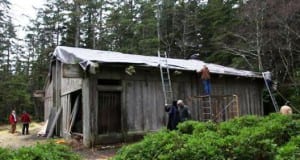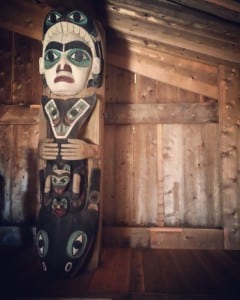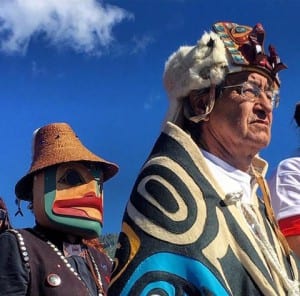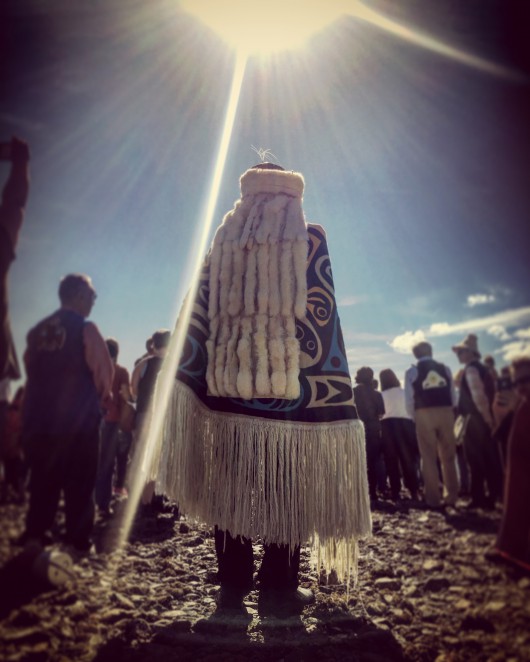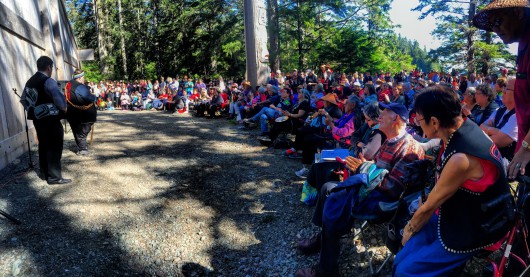
Richard Peterson of Kasaan, Central Council Tlingit and Haida President, addressing the hundreds of guests in front of the Whalehouse (copyrighted photo by Marijane Armour used with permission).
On September 3rd, Kasaan celebrated the restoration of the Son-i-Hat longhouse. Hundreds of visitors attended the event, dance groups came from throughout Southeast, and dignitaries included the current Chief Son-i-Hat, and Lieutenant Governor Byron Mallott. The Organized Village of Kasaan’s vice-president and one of the apprentice carvers share their thoughts about the restoration, and what it means to the community.
For the past five years, carvers have been working to restore the Haida longhouse in Kasaan. It is called Naay I’waans , The Great House, though many know it as The Whale House for some of the interior carvings.
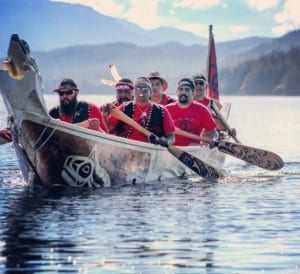
Klawock’s Heinyaa Kwaan canoe crew paddling into Kasaan for Rededication of the Whalehouse; Lawrence Armour, Robert Jackson, Jonathan Rowan, Ronnie Fairbanks, Leslie Isaacs and John Smith (copyrighted photo by Marijane Armour used by permission).
The structure was built in 1880. In the late 1930s, the Civilian Conservation Corps commissioned local carvers to renovate the building. It is the last remaining, traditional Haida longhouse in the United States, but was not maintained from 1940 until 2011. Fred Olsen is vice-president of the Organized Village of Kasaan.
“For all of the Haidas, it is a cultural landmark. It’s near and dear to our hearts. It’s a part of our soul. As it decayed, we knew we had to restore it.”
Olsen says it was the family home of chief Son-i-Hat. Ownership then transferred to the U.S. government, and the land and building are currently the property of Kavilco, Inc., a Native corporation created under the Alaska Native Claims Settlement Act.
The restoration took five years. The lead carver was Glenn “Stormy” Hamar. Hamar worked with three apprentices, Eric Haymar, Justin Henricks and Harley Holter. Holter says as they began restoration, you could see remnants of the original house, and the 1930s renovations. He says their intention was to keep as much of the original structure as possible, and they were able to retain about 80 percent of the existing building.
Holter says the project was a unique and amazing experience.
“I got to experience exactly what that longhouse experienced, just in a short fraction of the time that it’s experienced (things). Like the weather it’s had to go through, the vandalism. I got to see a whole lot of things about it that I’d never known, and I’d been going to that longhouse my whole life at that point. Once I got working on it, I saw a whole new side of it.”
Holter says he was surprised to find vandalism, which included bullet holes and graffiti.
“I was just blown away that someone could disrespect something like that, that much.”
There are no plans to use the restored longhouse for any specific purpose. It has remained open over the years, and is visited by locals and tourists. No meetings or events take place in it. Olsen says he hopes things will remain the same, but also sees cultural opportunities.
“One of the most inspiring moments in my life was being in there with all the dancers, and the life spirit in there was just amazing. So, I can imagine future culture camp-type activities, but I hope that it gets to just be used how it is.”
Olsen says the project would not have been possible without the support of many individuals and organizations.
“I would like to thank all of the people, Native and non-Native alike, who have shown us such an overwhelming outpouring of support and love for the Whale House. Haw’aa. Thank you very much.”
The restoration project was made possible through a partnership with the Organized Village of Kasaan, Kavilco and the Kasaan Haida Heritage Foundation. Additional funding was provided by the Rasmuson Foundation, Sealaska Corp., the U.S. Forest Service, the Alaska Mental HealthTrust Authority, and individual donors. More than $1 million was raised.

